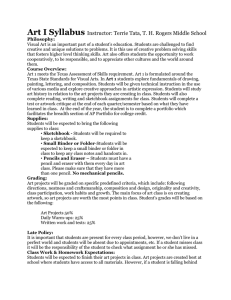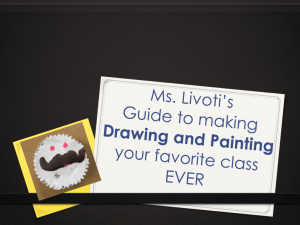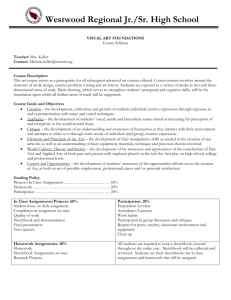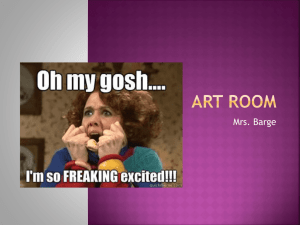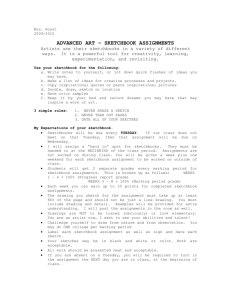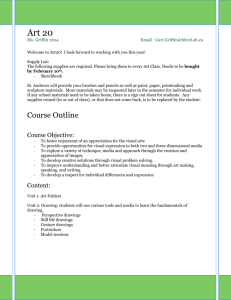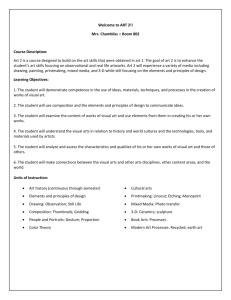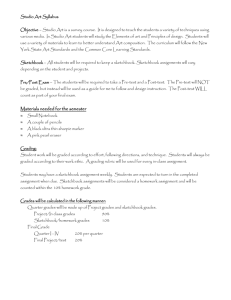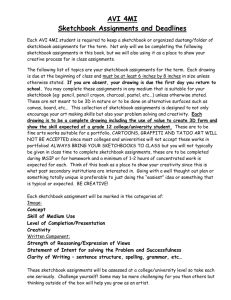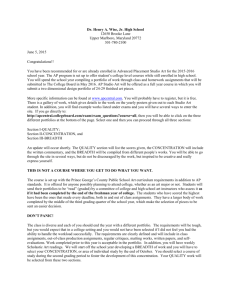HALIFAX WEST HIGH SCHOOL / R. L. Perry / 2015
advertisement
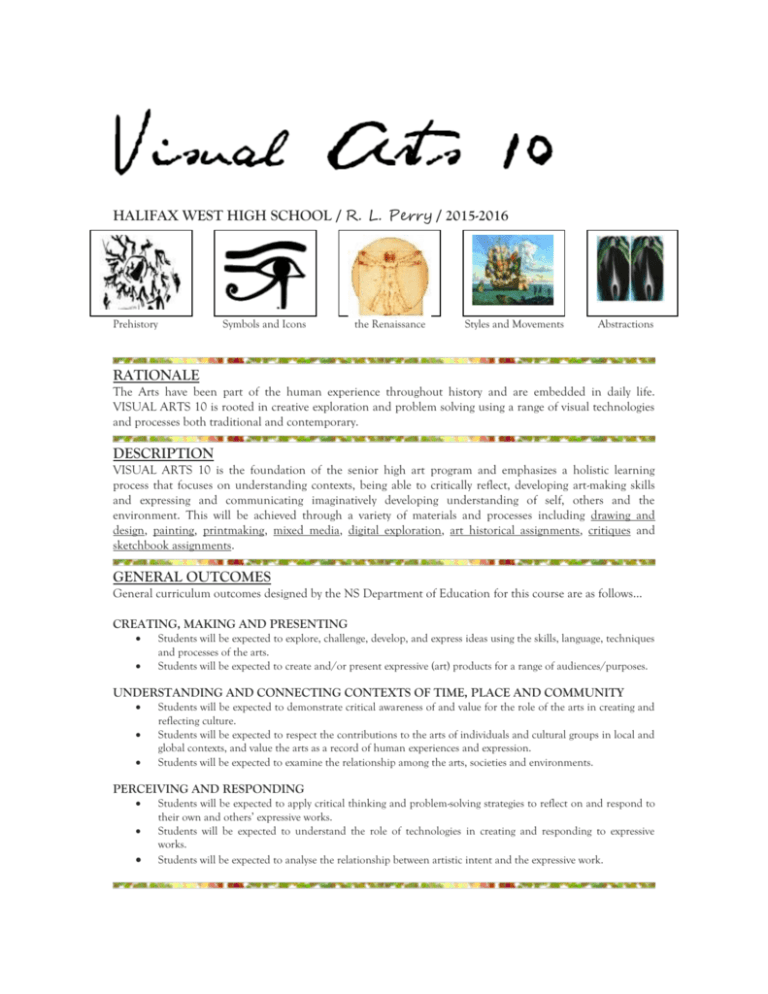
HALIFAX WEST HIGH SCHOOL / R. L. Perry / 2015-2016 Prehistory Symbols and Icons the Renaissance Styles and Movements Abstractions RATIONALE The Arts have been part of the human experience throughout history and are embedded in daily life. VISUAL ARTS 10 is rooted in creative exploration and problem solving using a range of visual technologies and processes both traditional and contemporary. DESCRIPTION VISUAL ARTS 10 is the foundation of the senior high art program and emphasizes a holistic learning process that focuses on understanding contexts, being able to critically reflect, developing art-making skills and expressing and communicating imaginatively developing understanding of self, others and the environment. This will be achieved through a variety of materials and processes including drawing and design, painting, printmaking, mixed media, digital exploration, art historical assignments, critiques and sketchbook assignments. GENERAL OUTCOMES General curriculum outcomes designed by the NS Department of Education for this course are as follows… CREATING, MAKING AND PRESENTING Students will be expected to explore, challenge, develop, and express ideas using the skills, language, techniques and processes of the arts. Students will be expected to create and/or present expressive (art) products for a range of audiences/purposes. UNDERSTANDING AND CONNECTING CONTEXTS OF TIME, PLACE AND COMMUNITY Students will be expected to demonstrate critical awareness of and value for the role of the arts in creating and reflecting culture. Students will be expected to respect the contributions to the arts of individuals and cultural groups in local and global contexts, and value the arts as a record of human experiences and expression. Students will be expected to examine the relationship among the arts, societies and environments. PERCEIVING AND RESPONDING Students will be expected to apply critical thinking and problem-solving strategies to reflect on and respond to their own and others’ expressive works. Students will be expected to understand the role of technologies in creating and responding to expressive works. Students will be expected to analyse the relationship between artistic intent and the expressive work. UNIT OUTCOMES Students will create drawings demonstrating knowledge of the six elements of art. Working from objects, photographs, still lives and imagination they will construct forms that represent the basics of contour, gesture, value, texture, shape and form, perspective and proportion, in black and white, and colour. Students will design works that demonstrate knowledge of pattern, rhythm, balance, emphasis, contrast and unity with mediums such as coloured pencil and pen and ink. Students will demonstrate knowledge of the colour wheel and it’s components through painting, mixing and blending their own colours and demonstrating how to achieve different colour schemes in both watercolour and acrylic mediums. Students will demonstrate how to create and print a series of relief prints, using linoleum tile or printing plate and carving tools as their relief media. Students will demonstrate compositional intelligence in the combination of mixed media to create new meanings and intentions with expression. This may be through collage, assemblage or found-object combinations, and may be two-dimensional, bas-relief or sculpture-in-the-round. Students will acquire, develop and use a vocabulary of art terms, techniques and styles as well as demonstrate knowledge of artists, art movements and art criticism, both verbally and in written form. ASSESSMENT/EVALUATION VISUAL ARTS 10 final grades will be an accumulation of formative and summative assessment practices. Various forms of evaluation including observation, small assignments, techniques lessons, major projects, sketchbook assignments, portfolio assessment, tests, self and peer evaluation. Students will complete a final process examination at the end of semester. The VISUAL ARTS grade will be based on the following breakdown… CREATING/MAKING- Major Projects 45% UNDERSTANDING/CONNECTING- Sketchbook/Exploratory/Techniques/Context 20% PERCEPTION/RESPONSE- Observation/Reflection/Tests/Critique/Self & Peer Evaluation 15% PROCESS EXAM-20% The semester is valued at 80% with a final process exam being the remaining 20% in the FINAL GRADE calculation. MATERIALS REQUIRED SKETCHBOOK 8.5 x 11” or 9 x 12” preferably bound not coiled 80-100 pages min. SKETCHING PENCILS at least three such as 2B, 4B, 6B WHITE ERASER BLACK FELT-TIP MARKER (ultra-fine ‘sharpie’ or ‘le pen’) COLOURED PENCILS GLUE STICK (large) BRISTOL BOARD (for your first assignment- portfolio construction) OPTIONAL… You may choose to have access to watercolour media (small paintbox or watercolour pencils) for colour work in your sketchbook as well as a small detail brush (number 0 or 00) as well as a medium round (number 6 or 8) Notes/ handouts may be stored in a binder BUT can be glued/ attached directly in your sketchbook. *I will be contacting DeSerres art store to see about providing all materials in a super–value kit. CONTACT THE TEACHER Rosemarie Perry (Ms. Perry) at 457-8900 ext. 5602327 e-mail Rperry@hrsb.ca or website www.artwithperry.com
